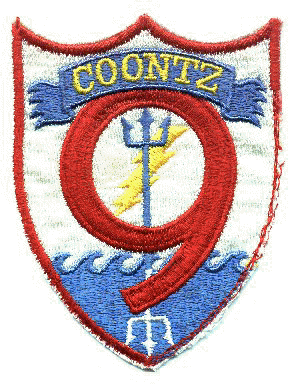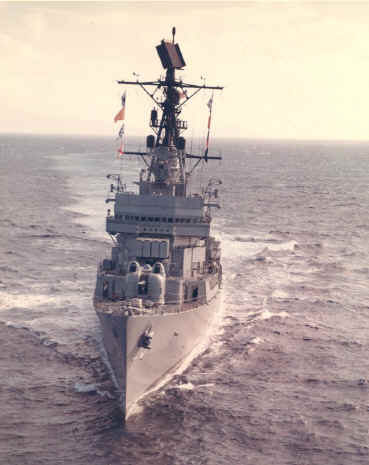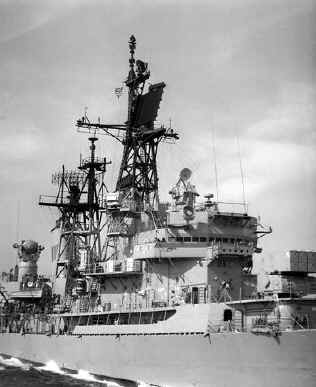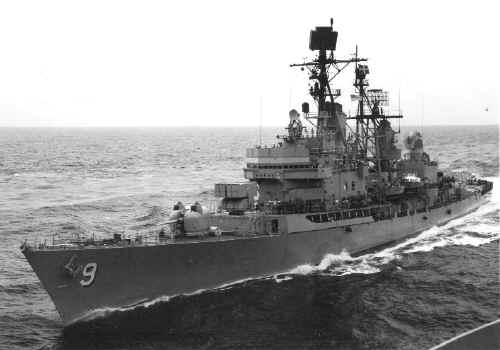|

ATTACK AT DAWN
By LCDR Mike Snyder, USN (ret)
At the time of this story, LCDR Snyder was
LT (jg)
and the Missile Officer (1973-1974)
U.S.S. COONTZ (DLG-9)
 Operating far from the fleet in an exposed position, USS
Coontz (DLG-9) steamed above cavitation speed in random patterns inside a
10-mile by 10-mile box. She was in
the Eastern Med on PIRAZ (Primary Identification and Radar Advisory Zone), the
closest US ship to the 1973 Mid East War.
The crew worked in a Condition Three wartime posture with one third of
the ships crew awake and at battle stations ‘round the clock.
The 5 inch 54 caliber gun and its MK 68 Gun Fire Control System were at
alert on the bow. Back aft, one of
the big, megawatt, AN/SPG-55 Missile Fire Control Radars and the twin-arm
missile launching system operated continuously.
There were live long-range Standard missiles on the rails, ready for
launch in an instant. In their
isolated cubbyhole the sonar gang squinted into hooded scopes searching for the
first faint glow indicating a hard target out in the depths.
Their electronic and intuitive evaluations coursed into the Underwater
Battery Fire Control System with the rocket thrown ASROC and tube-launched
torpedoes at the business end. The
Tactical Action Officer, ensconced in CIC, watched and questioned as the world
went on around him. He had written
authority to fire the weapons. We
were poised to respond to any air, surface, and subsurface attack within
seconds.
Operating far from the fleet in an exposed position, USS
Coontz (DLG-9) steamed above cavitation speed in random patterns inside a
10-mile by 10-mile box. She was in
the Eastern Med on PIRAZ (Primary Identification and Radar Advisory Zone), the
closest US ship to the 1973 Mid East War.
The crew worked in a Condition Three wartime posture with one third of
the ships crew awake and at battle stations ‘round the clock.
The 5 inch 54 caliber gun and its MK 68 Gun Fire Control System were at
alert on the bow. Back aft, one of
the big, megawatt, AN/SPG-55 Missile Fire Control Radars and the twin-arm
missile launching system operated continuously.
There were live long-range Standard missiles on the rails, ready for
launch in an instant. In their
isolated cubbyhole the sonar gang squinted into hooded scopes searching for the
first faint glow indicating a hard target out in the depths.
Their electronic and intuitive evaluations coursed into the Underwater
Battery Fire Control System with the rocket thrown ASROC and tube-launched
torpedoes at the business end. The
Tactical Action Officer, ensconced in CIC, watched and questioned as the world
went on around him. He had written
authority to fire the weapons. We
were poised to respond to any air, surface, and subsurface attack within
seconds.
The fleet commanders threat assessment
included Egyptian fast missile boats and an errant Israeli submarine suspected
to be in the area.
It was tense aboard the ship, especially so in CIC where the team was
tasked to identify and classify as friend or foe every air and surface contact
our sensors detected. It was a big order. The
two and three dimension air search radars, far up on the masts, reached out
hundreds of miles and pushed an astonishing number of targets down into the Navy
Tactical Data System. So many, in
fact, that the detection horizon and report flow had to be limited to keep from
overloading the system. The surface
tracker, using the venerable AN/SPS-10 surface search radar, watched for contacts out to about 30 miles.
The sea was strangely empty though.
The war had driven most of his potential targets to ground. Only a few courageous, and probably hungry, commercial
captains ventured out into the war zone.
search radar, watched for contacts out to about 30 miles.
The sea was strangely empty though.
The war had driven most of his potential targets to ground. Only a few courageous, and probably hungry, commercial
captains ventured out into the war zone.
A full bridge team of OOD, JOOD,
quartermaster, and Boatswains Mate of the watch with his helmsmen and lookouts
maneuvered the ship safely around in its appointed hole in the ocean. The watch officers had complete freedom of movement within
the PIRAZ station. In the daylight
some practiced Williamson Turns using a box or floating trash as the “man
overboard” target. Others
patrolled the edges completely touring the circumference in a four-hour watch.
One conning officer drew his initials in the sea using the 100 square
mile surface as a chalkboard. The
bridge team intently watched for periscopes.
They provided visual descriptions of radar contacts.
They ran the ships routine with announcements and functions such as:
Sweepers man your brooms, Relieve the watch, Mess Gear, Stand clear of mount 51
while conducting T checks, Permission granted to blow tubes, Darken ship, and
Taps. It was deceptively routine.
The weather was pleasantly warm. The
sea was flat calm and slick. It
looked dusty. The old SPS-10 could pick up a 50-gallon drum at 8 miles in
this calm
As a night time OOD, I maniacally demanded
a darkened ship. When I was
on watch most of the small bridge illumination and indicator lights were covered
with masking tape or black electricians’ tape, white lights were not tolerated
anywhere topside, and smoking was restricted for all on watch save the messenger
when he was below decks. Good night
vision was slowly won and instantly lost. But
the effort paid off when a contact peaked above the horizon, the side and
running lights revealing a target angle at ten or twelve miles.
In the pitch dark, I quizzed the watch standers on their duties and
pumped up the lookouts by challenging their skills at determining target angles.
We ran signal book drills between CIC, the bridge, and the signalman.
 From his gloomy corner at the back of the bridge the phone talker urgently spoke
above the whispers and murmur, “Bridge, CIC, surface contact
inbound on the starboard bow, range 10 miles, course 165 degrees true, speed 23
knots”. The
hair stood on my neck as I charged out onto the bridge wing.
Nothing visible! I called to
the lookouts to watch along the target bearing and went back inside.
My JOOD had begun a grease pencil track on the dimmed radar scope and his
marks showed a short line pointing directly at the ship.
Sonar heard nothing. The
electronics counter-measures suite (ECM) sensed nothing.
The TAO put the gun fire control radar into a search pattern on the
bearing and they too came up empty handed.
Unwaveringly the contact advanced, same speed, same course.
At seven miles the TAO put the gun on the bearing and called the CO.
Still, there was nothing to fire at.
Back out on the wing I strained for a sight, half expecting to see or
hear a torpedo boat on final approach. Oh
Jesus! The pucker factor got real
high and real tight. At about two
miles, as we all gnawed our lips, the contact evaporated.
It just broke up and disappeared from the screen.
What-was-that?!?! A few
minutes later the CO came out on the bridge, poked around a bit; assured himself
we all weren’t sniffing glue, spoke a few words of encouragement, and, with
his bedroom slippers shuffling softly, went back to his sea cabin.
It was just past 0100.
From his gloomy corner at the back of the bridge the phone talker urgently spoke
above the whispers and murmur, “Bridge, CIC, surface contact
inbound on the starboard bow, range 10 miles, course 165 degrees true, speed 23
knots”. The
hair stood on my neck as I charged out onto the bridge wing.
Nothing visible! I called to
the lookouts to watch along the target bearing and went back inside.
My JOOD had begun a grease pencil track on the dimmed radar scope and his
marks showed a short line pointing directly at the ship.
Sonar heard nothing. The
electronics counter-measures suite (ECM) sensed nothing.
The TAO put the gun fire control radar into a search pattern on the
bearing and they too came up empty handed.
Unwaveringly the contact advanced, same speed, same course.
At seven miles the TAO put the gun on the bearing and called the CO.
Still, there was nothing to fire at.
Back out on the wing I strained for a sight, half expecting to see or
hear a torpedo boat on final approach. Oh
Jesus! The pucker factor got real
high and real tight. At about two
miles, as we all gnawed our lips, the contact evaporated.
It just broke up and disappeared from the screen.
What-was-that?!?! A few
minutes later the CO came out on the bridge, poked around a bit; assured himself
we all weren’t sniffing glue, spoke a few words of encouragement, and, with
his bedroom slippers shuffling softly, went back to his sea cabin.
It was just past 0100.
Ghosts.
Radar ghosts.
That’s what this scary phenomenon was labeled.
The Med had played strange tricks on me on an earlier cruise. A lookout reported a strange appearing ship on the horizon.
With my binoculars, I saw it clearly.
The ship was suspended just above the horizon looking short and fat, like
a loaf of squashed bread. CIC
cranked the radar out and discovered a ship over the horizon, nearly 50
miles away. That didn’t make sense, but that’s what the radar
repeater was telling us. When we
pushed the radar horizon out to its limits we could clearly see both the north
and south shore of the Mediterranean. They
appeared much, much closer than we knew them to actually be. Ships were visible all up and down the Med.
This strange effect persisted throughout the afternoon.
The explanation was ducting. Radar
and visible light was trapped between the sea and an atmospheric layer causing
the radar, and our eyes, to sense objects much farther than was normally
possible. Thus our nighttime
contact was relegated to the status of a radar ghost, an unexplained anomaly.
Not many nights later another watch team reported an
approaching contact. The TAO danced
through the rehearsed procedure; wake up the CO, put every available sensor and
weapon out on the bearing, and sweat. They
got to breathe again when the contact broke up inside two miles.
People began to get antsy and ask, “How many more times are we going to
go through this crap”?
Awakened from a fair nights sleep, I
relieved the deck and conning officer at about 0345.
As always, I minimized the scope illumination, taped over the lights,
harangued the watch into making the bridge truly dark, then settled into the
routine. I enjoyed the morning
watch. It was usually quiet, most
of the training and drills having been completed hours before.
It was shorter than the normal 4 hours allowing me to get breakfast, I
got to wake up the ship, I saw the sunrise, and I was excused from quarters.
Not bad! I assured myself
there were competent helmsman and lookouts on watch with me and patrolled the
PIRAZ sector as vigorously as night-ordered 14 knots would allow. In the east the first faint glow of dawn showed high in the
sky. “Sir, surface
contact, port beam, 9 miles, 21 knots, CIC reports constant bearing, decreasing
range.” Oh
shit, here we go again! Out on the
bridge wing I peered into the dark, alternately looking through, then over my
binoculars. I glanced slightly away
to move the retinal blind spot off the target line.
Nothing! Not a damned thing!
As before, the TAO trained all the sensors to the bearing, but he
didn’t wake the CO for this one. Difficult
minutes passed, perhaps 20. As
before, the contact dissolved from the scope when it reached what was the normal
edge of sea clutter. Excited and
curious, I remained on the wing.
 More minutes passed.
Then, out of the gloom, just above the surface I saw movement.
It rose and fell irregularly and advanced in waves.
Closer, closer . . .
There! . . Birds! . . Yeah, ducks!
The flat light of early dawn revealed a flight of ducks heading south for
Egypt and the wetlands of the Nile delta. Skimming
along in loose formation, their wings beat independently.
Sensing the ship ahead the formation broke up, silently spreading around
and over us. I
guessed there were about 50 individuals in the flight.
They quickly disappeared into the gray on the opposite side.
The radar did not re-establish contact as the ducks flew on.
More minutes passed.
Then, out of the gloom, just above the surface I saw movement.
It rose and fell irregularly and advanced in waves.
Closer, closer . . .
There! . . Birds! . . Yeah, ducks!
The flat light of early dawn revealed a flight of ducks heading south for
Egypt and the wetlands of the Nile delta. Skimming
along in loose formation, their wings beat independently.
Sensing the ship ahead the formation broke up, silently spreading around
and over us. I
guessed there were about 50 individuals in the flight.
They quickly disappeared into the gray on the opposite side.
The radar did not re-establish contact as the ducks flew on.
Later, discussing this with the radar folks, we concluded
the flat calm sea allowed us to pick the ducks up as they flew into the radar
beam, the flight being sufficiently compact to give a return.
When they reached the inner radar range resolution, then dispersed to fly
around the ship, they vanished from the scope, each bird individually too small
to provide a return. Outbound,
it took some miles for them to reform into the tight group, while their
backsides, and the trailing edges of wings and feathers presented a poor
reflecting surface.
The CO slept easier after that and I felt pretty good
about solving the mystery. Alerted
to the phenomenon, other OODs remained on the bridge wing long enough to confirm
ducks heading south.

 

|
